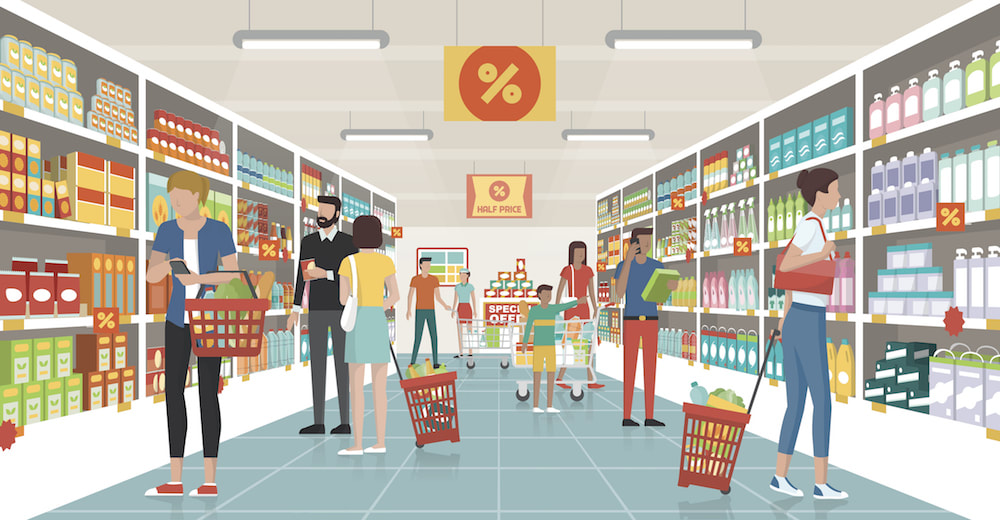
As we examine brick & mortar today, It would seem that all the buzz about how retail stores are doomed has turned out to be just what it was: buzz, untrue, inaccurate and nothing more than a bunch of rubbish brought on by those driving technology and e-commerce sites.
For the past few years, these authors have been able to get away with posting opinion as fact. But now we can have a closer look and judge for ourselves if brick & mortar is here to stay.
LET’S TAKE A LOOK AT THE FACTS!
For starters, many retailers that posted 2nd quarter results have seen their best quarter in quite some time. Leading with outstanding news is Target. CEO Brian Cornell stated that for the second consecutive quarter, traffic growth is better than we’ve seen in well over ten years, driving 6.5 percent comp growth. Other chains are also witnessing welcomed increases in same-store sales were Best Buy, Lululemon, TJX, Home Depot, Kohl’s, Williams-Sonoma, Lowe’s, DSW, DXL, Walmart and the list goes on.
This is not a fluke. It starts with the fact that our economy is booming and for the first time in years, consumers are feeling confident with more money in their pocket. In fact, consumer confidence has increased to the highest level we’ve seen in 18 years. The bottom line: people are getting back to one of their favorite pastimes, which is shopping, and yes they are shopping in malls and stores.
Why? Because stores have the one advantage the internet does not and that is the opportunity to see the item in real life. You can touch it, feel it, try it and make sure it’s what you want before you buy it. And there is no better opportunity for browsing, which leads to impulse buying, a great win for retailers and one not easily provided online.
FOOT TRAFFIC IS UP TOO
A study recently reported by GroundTruth stated the Q2 foot traffic was up overall from Q1 particularly with Home Improvement, Malls and Off-Price Apparel leading the charge. However, as customers come back to the malls, no doubt other retailers will benefit as well. Macy’s along with Marshall’s and Old Navy have all experienced increases in traffic, no doubt why those companies posted strong 2nd Quarter comp store sales as well.
It is true that internet sales will continue to grow as well as overall spending increases, but there is a lot to be said for the desired trip to the store or mall. Now that consumers are feeling better about their wealth and our economy, expect to see traffic continue to increase, which is excellent news for all brick and mortar retailers.
SO, WHAT ABOUT ALL THE STORES CLOSING?
It’s a fact that there are many stores closing, but that has always been the case. Stores come and go for a variety of reasons. It is not uncommon that consumer desires can change, locations can lose their edge, and yes, retailers do go out of business. However, even though there is the expected closure of 8,828 stores in 2018, there is also the commitment of opening 12,663 new stores this year. That’s a brick and mortar gain of 3,835 locations! Why? Because retailers and investors are seeing the proof of promising brick & mortar sales growth caused by the fact that "consumers are getting back to shopping!"
In addition, many malls are being renovated, built, expanded and more malls are opening. The newest focus is to make them more elaborate with a variety of “experiences” customers will enjoy. We often hear how history repeats itself. Back in the 80s, we had our last mall boom when for the first time, malls were enclosed, many with food courts and even others featuring movie theaters, arcades and rides for children. That boom lasted 20 years. Today, these new “experience” malls will focus on different types of attractions customers can appreciate, ranging from health spas to various forms of entertainment and phenomenal restaurants. One such mall, scheduled to open May 2019 complete with an indoor ski slope, is the American Dream Meadowlands mall consisting of 4.8 million square feet, making it only slightly smaller than The Mall of America. Also, there is another American Dream Mall planned for Miami Florida that will be the largest mall in the country with over 6 million square feet.
WHAT ABOUT ALL THE NEW BRICK & MORTAR PLAYERS?
It seems that every day we are reading about another first-time venture into brick & mortar from manufacturers wanting to deal directly with customers to all types of e-tailers.
The list continues to grow from companies like Amazon along with Bool & Branch, Allbirds, Everlane, Harry’s, and Untuckit. Moreover, some of these companies who one time were only interested in being an online retailer are being very aggressive with their store openings such as Amazon planning to open 3000 more Amazon Go stores and Warby Parker looking to have 100 stores within the year as well as Casper looking at double that amount with over 200 locations.
If brick & mortar was doomed as we were to once believe, would it make sense for all these companies and investors to be syncing big dollars into physical locations? Absolutely not.
AND HAVE YOU SEEN ALL THE POP-UPS?
Not only do we see an increase in physical stores, but the newest player in the world of brick & mortar is the “pop-up.” Pop-up stores have been around a long time, but in the past, they were independently-owned businesses usually with a small kiosk operation in a mall, train station, airport or on a busy city sidewalk.
Many retailer players are experimenting with pop-ups which are less expensive to open and operate. It gives the retailers an opportunity to test product, concepts and to gain additional awareness of their brand for a fraction of the cost of opening a physical store and with a lot less risk should it prove to be unsuccessful. The pop-up industry has already reached over 10 billion in sales featuring such retail players as Party City, Hudson Bay, Macy’s and Amazon. Moreover, along with the pop-up rage, there is also the social media tie-in as many of these retail players are using Instagram to promote their pop-up and its merchandise.
Furthermore, many e-commerce players are also entering the pop-up world with such players as Ainsel, Goop, Brandless and many more.
Lastly, pop-ups are also appearing inside bigger stores, creating the “store-within-a-store” concept. This type of brick & mortar location is proving to be very successful for retailers like Best Buy, J C Penny and Nordstrom. For example, Sephora has added numerous locations to their store count list simply with their store-within-a-store partnership with J C Penny.
STILL NEED MORE PROOF?
Well, let’s take a look at some sales numbers. It is true that online retail sales during the holidays last year rose 14.7%, which is excellent news for e-commerce and certainly needs to be recognized.
However, the majority of holidays sales still took place in stores. According to a report presented in RetailDive.com, nearly 85% of all holiday sales last year were made in brick & mortar stores with only slightly less than 15% taking place online! Moreover, for the year, the percentage for brick & mortar versus online sales was even higher at 86% for brick & mortar and 14% for all online sales.
There is no doubt that technology will continue to introduce new methods for shopping and more conveniences. As that happens, more and more shoppers will shop either on their computers, tablets or mobile phones. However, it will be centuries if ever before we no longer have consumers who enjoy going to a store. The experience will change, the merchandise will change and how we purchase items will change all because of technology. Today we are looking at everything from custom fitting clothes made while you wait to smaller stores with items only for the customer to see, buy not take the item. Yet by the time they get home, their purchase will be waiting for them. Delivery is the future even for brick & mortar stores and we are seeing faster and different methods of delivery taking place almost every day.
Even with the internet and fast home delivery, the one thing you cannot replace is the excitement and fun one can experience when visiting a store or mall. Most importantly, as long as retailers remember to keep their stores staffed with well-trained employees, their opportunities for business will continue to grow, especially now with our booming economy. Add to that the perfect website that treats the in-store shopper and online shopper as the same customer, and you’ll have a win-win.
The internet is here to stay but so is brick & mortar!
Art Suriano
[email protected]
201-841-1090











 RSS Feed
RSS Feed